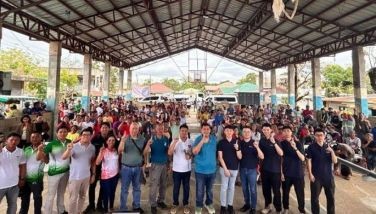Sustainability

Last February, representatives of 15 Swedish companies and groups visited the Philippines, assessing investment prospects. I’ve been told that from the land of Volvo and Electrolux (and one recent royal wedding), we may soon see a local outlet of furniture giant Ikea.
One day Sweden may even reopen its embassy here, if bilateral interaction intensifies. We have 15,000 Filipinos working in Sweden, most of them in commercial shipping, and now Swedish investor interest in the Philippines is picking up.
Positive European interest, officially or in terms of trade or leisure travel, in an Asia-Pacific nation – a long way from Europe – is generally a sure indication of the country’s buoyant economic performance.
In this aspect we are way behind many of our Southeast Asian neighbors. Even with the Eurozone crisis, they are still the favored destinations for European tourism and investment. While European embassies are shutting down in Manila (Finland is the latest), the Europeans are basing their diplomatic missions in the region in neighboring capitals.
Sweden is no exception; its ambassador, Klas Molin, who is married to a Filipina, shuttles between Manila and the embassy in Bangkok.
Diplomatic presence is a good indication of the performance attached to the host country by foreign governments. The diplomatic infrastructure expands with bilateral relations, so that massive modernization of the US embassy in Manila is significant.
To match the US embassy expansion, China wanted to build its mission on several hectares of the Cultural Center of the Philippines property in the reclaimed area of Manila Bay. But the CCP has other plans for the area.
Beijing may instead want to follow other governments and set up shop around McKinley Hill in Taguig, where the embassies of Britain and South Korea are now housed in modern buildings. Wealthy Singapore also has its own building on prime property at the heart of Bonifacio Global City.
For now, investor interest even from governments with no embassies in Manila is a good start. The Europeans like the focus on good governance of the Aquino administration.
But investors are aware that there’s still a lot of rot in the system. The question on everyone’s mind, when discussing reform initiatives, is whether these can be sustained. Specifically, whether the reforms will survive beyond June 30, 2016.
Sweden is no different. At their National Day reception last week, Ambassador Molin said they hear about recent Philippine reforms, strong economic growth, the investment grade.
“We are picking up these signals,†Molin told guests. “If there is any advice we can give, it is to make these reforms stay, to institutionalize them, make the reforms inclusive.â€
Other foreign diplomats say the same thing in private conversation.
* * *
In Myanmar for the World Economic Forum (WEF) on East Asia, President Aquino pitched the Philippines to a gathering of investors.
A pariah state until not too long ago, Myanmar is in fact generating more buzz than the Philippines these days in this region, thanks to sweeping democratic reforms and the charismatic presence of Nobel Peace laureate Aung San Suu Kyi.
It’s noteworthy that Myanmar was chosen ahead of the Philippines as the venue for the WEF on East Asia. It’s also noteworthy that even Filipino industrialists are looking at Myanmar as an investment destination.
Westerners have pointed out to me that Myanmar is still woefully lacking in the infrastructure and skilled human resources needed for certain types of foreign direct investment. Its capital Naypyidaw, however, successfully hosted the WEF event – the nation’s debut on the world stage.
If there is concern about backsliding on reforms in the Philippines, the concern is worse in Myanmar. But foreign interest is there, and steadily growing.
For example, Indonesian state corporations, flush with cash as their economy grows, are already in Myanmar, winning deals this year for tin mining, cement production and construction projects.
The Indonesians are also in Vietnam, where up to 90 percent foreign ownership is allowed in cement plants (as in Myanmar), and in Timor Leste. The Indonesians are just starting to look at the Philippines, with Minister for State Enterprises Dahlan Iskan visiting Manila and meeting with P-Noy about two weeks ago.
Myanmar also happens to be located at the crossroads between India and Southeast Asia, and is positioning itself as an economic gateway. And for decades its main benefactor was China, now a massive source of tourists and manufacturers looking to escape rising production costs in their own land.
We have to consider Myanmar as serious competition.
* * *
By the time we host the WEF on East Asia next year and the Asia-Pacific Economic Cooperation summit in 2015, we should be able to present a solid package of incentives for investors, along with a clear national direction in the foreseeable future and an assurance to the world that reforms are irreversible.
P-Noy and his allies by that time should have either finalized or set in motion political and economic reforms long sought by those who have done business here or are planning to. Infrastructure upgrading should be vigorously underway.
Yesterday, P-Noy inspected the Laguindingan International Airport in Misamis Oriental, which is set to open this Saturday. It will serve as the main gateway for the Northern Mindanao cities of Cagayan de Oro and Iligan.
Built by a consortium of the Ayala Group and South Korea’s Hanjin Heavy Industries, the opening of the Korea-funded project had to be pushed back from April 30 because the lack of certain navigation and related facilities requires the reduction of flights to its service areas. For this reason, the opening of the airport this Saturday is being opposed by local businessmen.
Philippine airports are still waiting for more navigation equipment. But the Japan-funded Computer Navigation System / Air Traffic Management project, with a Japanese lead contractor, French navigation system and New Zealand engineering consultant, is stalled at the Department of Transportation and Communications. “Re-initiation†of the project may have to wait at least until September. Not the best signal to send to foreign investors.
All three countries involved in the project have embassies here and look like they’re here to stay, with the Kiwis raising their profile. But their travelers and investors are also being lured by our neighbors, and competition is stiff.
With recent positive developments, we are attracting the world’s interest. The challenge is to sustain that interest, and see it translated into solid investment.
- Latest
- Trending





























